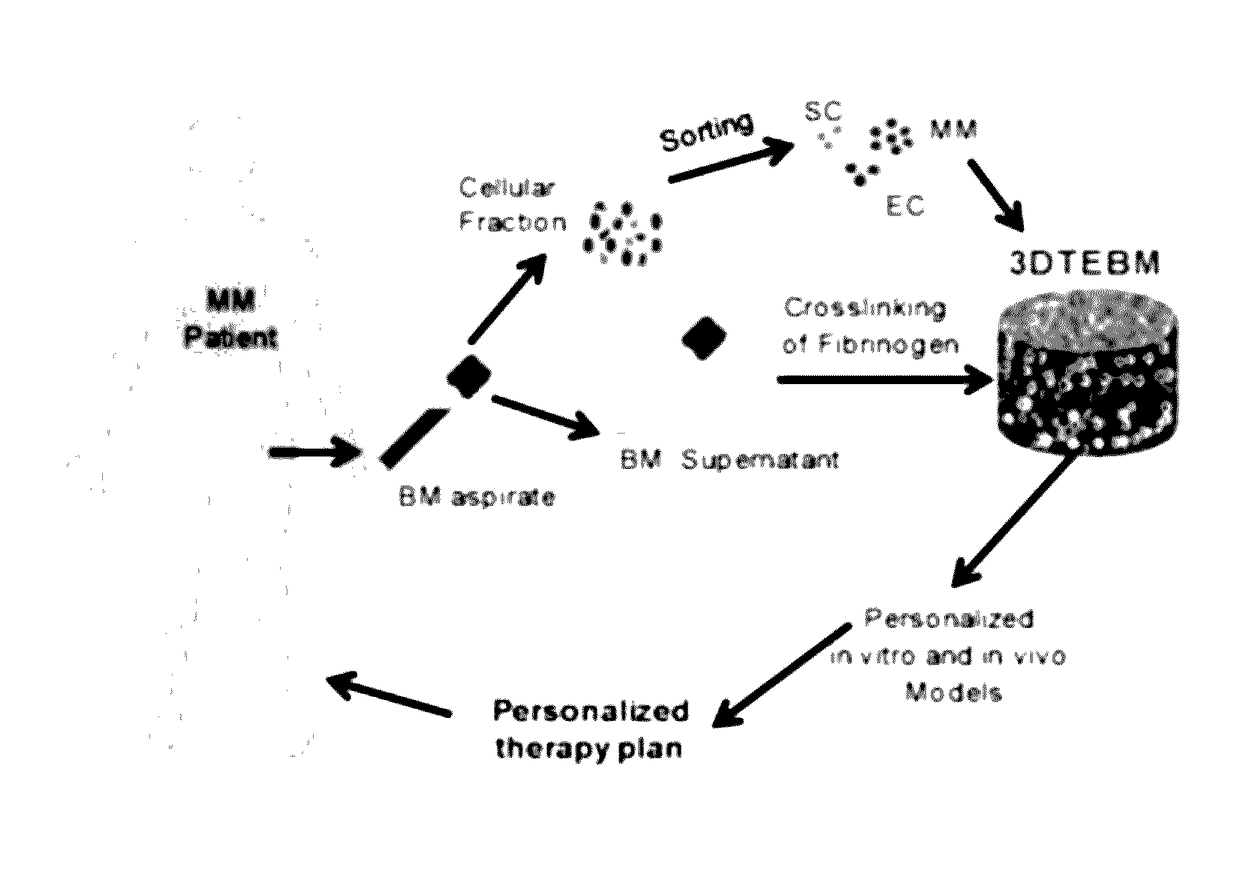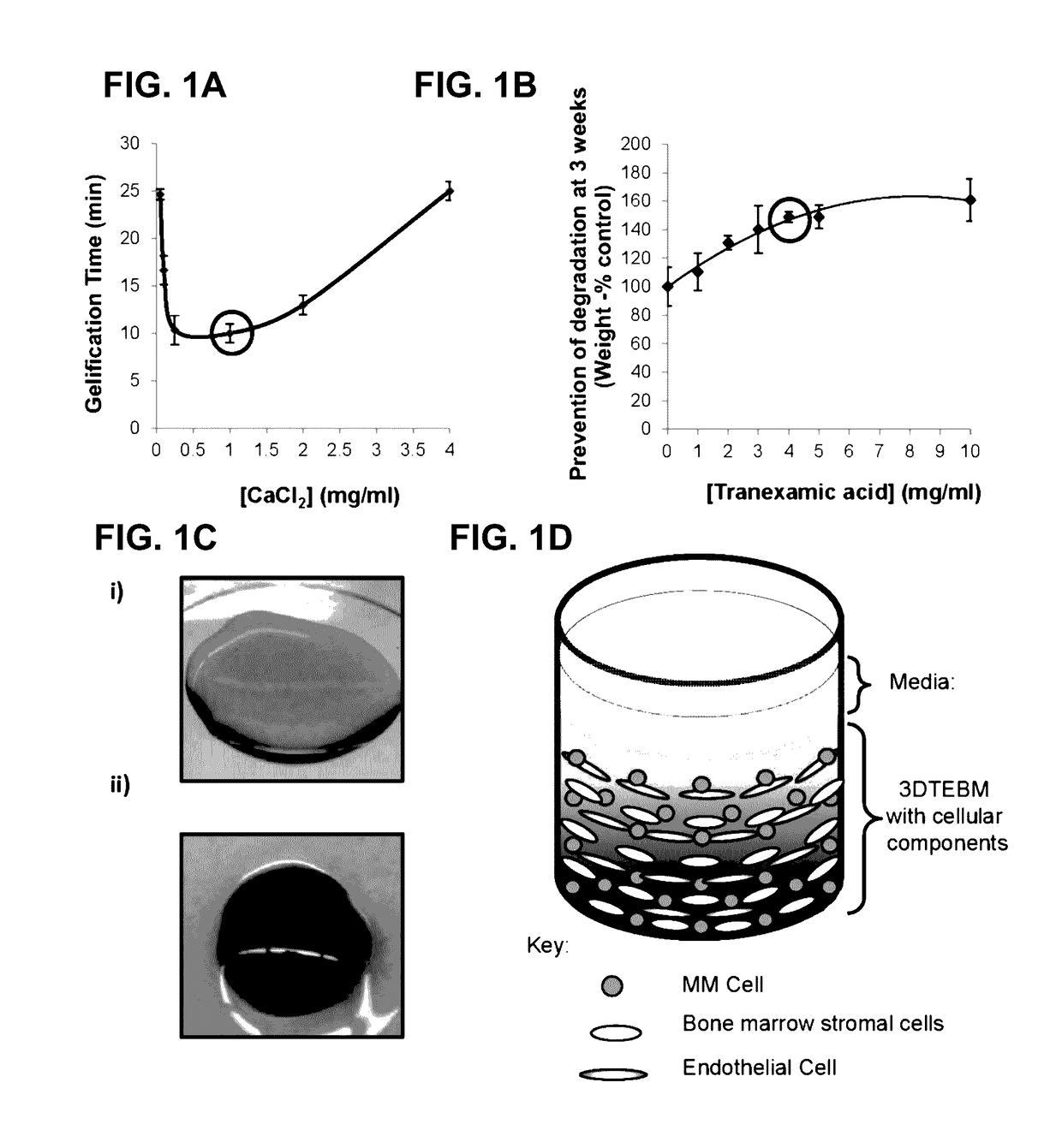3D tissue-engineered bone marrow for personalized therapy and drug development
a bone marrow and personalized therapy technology, applied in the field of tissue-engineered bone marrow, can solve the problems of inability to accurately predict, each has its limitations, and the in vitro efficacy is not clear, so as to increase the stability of 3dtebm, the effect of maximizing the scaffold and increasing the cell density
- Summary
- Abstract
- Description
- Claims
- Application Information
AI Technical Summary
Benefits of technology
Problems solved by technology
Method used
Image
Examples
example 1
the 3DTEBM
[0072]The MM cell line (MM1s, and MM1s-GFP-Luc) and BM stromal cell (BMSC) line Hs5 were a kind gift from Dr. Irene Ghobrial, Dana-Farber Cancer Institute, Harvard Medical School, Boston, Mass. Human umbilical vein endothelial cells (HUVECs) were purchased from Lonza. All cells were cultured at 37° C., 5% CO2; MM1s cells in RPMI1460 media (Corning CellGro, Mediatech, Manassas, Va.) supplemented with 10% fetal bovine serum (FBS, Gibco, Life technologies, Grand island, N.Y.), 2 mmol / L of L-glutamine, 100 U / mL Penicillin and 100 μg / mL Streptomycin (CellGro, Mediatech, Manassas, Va.), HUVECs in EGM-2 completed media (Lonza, Walkersville, Md.), and stromal cells (Hs5) in Dulbecco's Modified Eagle's Medium (DMEM, Corning CellGro, Mediatech, Manassas, Va.) supplemented with 20% FBS, L-glutamine, and penicillin and streptomycin. Before experiments MM1s, Hs5 stromal cells, and HUVECs (1×106 cells / ml) were pre-labeled with calcein violet (1 μg / mL), DiD (10 μg / mL), or DiI (10 μg / mL) ...
example 2
ensional (3D) Tissue-Engineered Bone Marrow (3DTEBM) Cultures
[0075]The three-dimensional (3D) tissue-engineered bone marrow was formed through cross-linking of fibrinogen (naturally found in the plasma of the BM supernatant) with calcium chloride concentrations 0-4 mg / ml. Gelification time was measured and the calcium chloride concentration that induced the fastest gelification time was selected for further studies. Prevention of degradation of the fibrin fibers and stabilization of the scaffolds were achieved by addition of tranexamic acid 0-10 mg / ml. Stability of the scaffold was measured at 3 weeks by weight of scaffolds compared to the weight of non-stabilized scaffolds, and the tranexamic acid concentration that induced the maximal stabilization was selected for further studies. Briefly, 3DTEBM was formed by mixing the following components to achieve final concentrations of 400 μl / ml plasma, 1 mg / ml calcium chloride, and 4 mg / ml tranexamic acid diluted in RPMI completed media t...
example 3
metry and Cell Proliferation
[0076]For flow cytometry analysis, an internal control (MM1s-calcein violet) was added and a minimum of 5,000 events were acquired using BD FACS Aria (BD Biosciences) and DiVa v6.1.2 software. The data was analyzed using FlowJo program v10 (Ashland, Oreg.). MM cells or CD138+ cells were identified by gating cells with a high GFP / DiO signal (excitement, 488 nm; filter, 530 / 30 nm); Hs5 stroma or CD138-stromal cells were identified by gating cells with a high DiD signal (excitement, 638 nm; filter, 660 / 20 nm); HUVECs were identified by gating cells with a high DiI signal (excitement, 488 nm; filter, 585 / 15 nm); and MM1s cells control were identified by gating cells with a high UV signal (excitement, 355 nm; filter, 450 / 50 nm). A 3DTEBM was digested with type I collagenase at 25 mg / ml for 2 h at 37° C. Classic bi-dimensional (2D) cultures were washed with PBS and removed by pipetting. The effect of cell density (5×103-50×103 cells / well) of MM1s-GFP, Hs5 strom...
PUM
| Property | Measurement | Unit |
|---|---|---|
| concentration | aaaaa | aaaaa |
| concentration | aaaaa | aaaaa |
| concentration | aaaaa | aaaaa |
Abstract
Description
Claims
Application Information
 Login to View More
Login to View More - R&D
- Intellectual Property
- Life Sciences
- Materials
- Tech Scout
- Unparalleled Data Quality
- Higher Quality Content
- 60% Fewer Hallucinations
Browse by: Latest US Patents, China's latest patents, Technical Efficacy Thesaurus, Application Domain, Technology Topic, Popular Technical Reports.
© 2025 PatSnap. All rights reserved.Legal|Privacy policy|Modern Slavery Act Transparency Statement|Sitemap|About US| Contact US: help@patsnap.com



